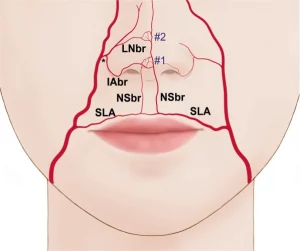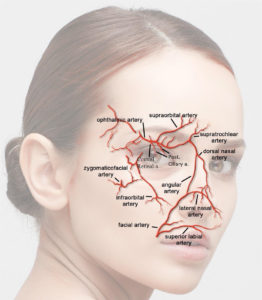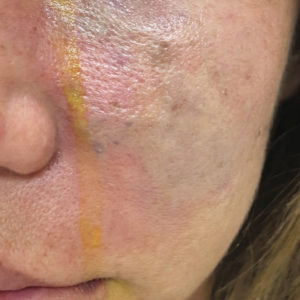Following the publication of my post on cheap cosmetic injectables for Mamamia last weekend, I’ve been inundated by questions from people I’ve never met on social media, asking about the safety of injectables and specifically, of dermal fillers.
One person said she’d been considering fillers to her lips and cheeks, but is now worried and scared and “How can you avoid getting a vascular occlusion? Is getting fillers in lips and cheeks ok?”
As I do always, I encouraged her to seek a qualified and experienced cosmetic injector and to ask about their setup for recognising and handling a complication should it occur.
It did get me thinking though, about how weekly now, we are seeing “botched” injectables on social media, not just dermal fillers, but also antiwrinkle treatments, and awareness is rising, but many people still seem unaware of what can go wrong, and equally, what that might look like because with rising awareness, is also rising anxiety which is good to some extent, and beyond a point, unhelpful.
Here is an image of the face, with a simplified drawing of the facial artery, which supplies the face, and its branches with focus on the area around the mouth, among the commonest areas that dermal filler is requested for and competed on.


When I did filler training (it was a weekend course over 2 days) years ago, we each injected 1/2 a side on a model eg 1/2 a lip or 1/2 a cheek under supervision. I was horrified at what could go wrong, and how, after this 2 day course for doctors, we were essentially given permission to go out and do dermal fillers, limited only by (in my case given my surgical background) common sense and a healthy fear of what could possibly go wrong.
So how does a vascular occlusion occur?
A vascular occlusion (VO) occurs when blood is no longer able to pass through a vessel. It may be a complete blockage or a partial one, causing a reduced blood flow to the parts of the body downstream from it.

A VO may be caused by many things, but in the case of aesthetics, it is most commonly caused by the accidental injection of dermal filler into a blood vessel. If left untreated, a VO of a blood vessel supplying the skin can ultimately lead to skin death due to loss of blood flow to it.
How common is vascular occlusion?
The reported rate of VO for all dermal fillers is thought to be around 1:100,000 cases, however it is widely understood among practitioners that this is likely widely underreported for the following reasons:
A summary by the FDA following a panel meeting on dermal fillers on March 23rd 2021 had this to say:
What does this all mean?
The report from the FDA, which is likely reflective of the state of most countries, shows that serious injury reports from the use of medical devices ie dermal filler have steadily risen, from 94 cases in 1996 to 1146 in the USA in 2020, a total of 10,325 cases between 1996-2020.
Keep in mind, these reports are in one country, and are assumed to be underreported because of the number of cases that go unnoticed or missed unless they cause serious and severe adverse outcomes.
So what is the take-home message?
You would, I hope, never consider getting surgery, even minor surgery, from someone who was not adequately qualified and experienced and did not operate from clean and medical premises. The premises themselves, is your assurance of the kind of care you should be expecting, so why would you compromise that with medical aesthetics and injectables, or anything that punctures the skin barrier such as many skin therapies?
Safety should always be first for you, and your treating clinician and if they cannot adequately reassure you, then you should not be going ahead.
As someone who has seen poor outcomes, they can often be harder to undo when I don't always know what was done, what was used, and how much of it was used. These are all medical procedures, and as a doctor, I have a duty of care to each and every one of my patients to educate them, consent them to the best of my ability and their understanding and to say no if I do not feel their expectations are realistic. After the procedure, I have a duty of care to manage any emergencies that arise in a timely manner and to see them through until resolved even if that means referring them on to someone else.
These are the basics every medic learns around patient safety and should be your assurance even if something goes wrong, since medical procedures can never be guaranteed. So please, choose wisely, choose someone qualified and experienced who can get themselves and you out of trouble if it happens. Medical procedures are not just beauty and should never be treated as such.
| Monday: | By agreement only |
| Tuesday: | CLOSED |
| Wednesday: | 10:00 - 17:00 |
| Thursday: | 10:00 – 18:00 |
| Friday: | 09:00 – 17:00 |
| Saturday: | 09:00 – 15:00 |
Skin Essentials will reopen the week beginning 11th October 2021.
Per NSW government regulations, only double vaccinated patients will be served when we reopen and we will be checking vaccination certificates for all patients upon booking. This requirement may change as of December 1st, and we will advise you accordingly.
Please email us (contact@skinessentials.com.au) or text us (0413174654) your vaccination certificate as soon after booking as you can. We will not be able to see anyone for treatments or confirm appointments without this.
In the interest of full disclosure, transparency and patient safety, all patient facing staff will be fully vaccinated by the time of reopening. Please read our reopening FAQ for more information.